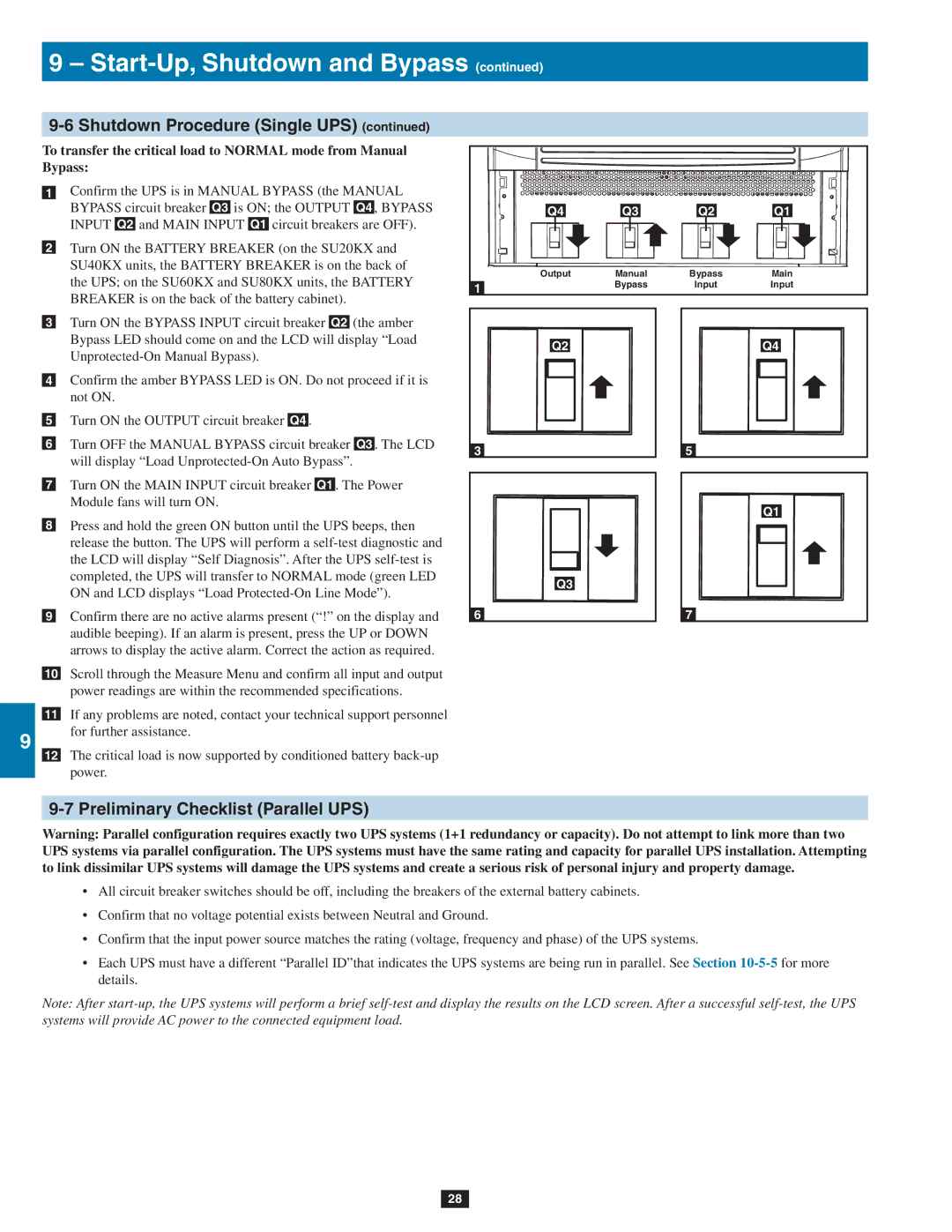
19 – Start-Up, Shutdown and Bypass (continued)
2
3
|
|
|
|
| |
To transfer the critical load to NORMAL mode from Manual |
|
|
|
| |
Bypass: |
|
|
|
| |
11. | Confirm the UPS is in MANUAL BYPASS (the MANUAL |
|
|
|
|
| BYPASS circuit breaker Q3 is ON; the OUTPUT Q4 , BYPASS | Q4 | Q3 | Q2 | Q1 |
| INPUT Q2 and MAIN INPUT Q1 circuit breakers are OFF). |
|
|
|
|
22. Turn ON the BATTERY BREAKER (on the SU20KX and |
|
|
|
| |
| SU40KX units, the BATTERY BREAKER is on the back of | Output | Manual | Bypass | Main |
| the UPS; on the SU60KX and SU80KX units, the BATTERY | ||||
| 1 | Bypass | Input | Input | |
| BREAKER is on the back of the battery cabinet). |
|
|
| |
|
|
|
|
| |
4
5
6
7
8
33. Turn ON the BYPASS INPUT circuit breaker Q2 (the amber Bypass LED should come on and the LCD will display “Load
44. Confirm the amber BYPASS LED is ON. Do not proceed if it is not ON.
55. Turn ON the OUTPUT circuit breaker Q4 .
66. Turn OFF the MANUAL BYPASS circuit breaker Q3 . The LCD will display “Load
77. Turn ON the MAIN INPUT circuit breaker Q1 . The Power Module fans will turn ON.
88. Press and hold the green ON button until the UPS beeps, then release the button. The UPS will perform a
99. Confirm there are no active alarms present (“!” on the display and audible beeping). If an alarm is present, press the UP or DOWN arrows to display the active alarm. Correct the action as required.
10Scroll through the Measure Menu and confirm all input and output power readings are within the recommended specifications.
Q2
3 |
Q3 |
6 |
Q4
5 |
Q1 |
7 |
11If any problems are noted, contact your technical support personnel
9 | for further assistance. |
12 The critical load is now supported by conditioned battery |
power.
10
11
12
13
14
9-7 Preliminary Checklist (Parallel UPS)
Warning: Parallel configuration requires exactly two UPS systems (1+1 redundancy or capacity). Do not attempt to link more than two UPS systems via parallel configuration. The UPS systems must have the same rating and capacity for parallel UPS installation. Attempting to link dissimilar UPS systems will damage the UPS systems and create a serious risk of personal injury and property damage.
•All circuit breaker switches should be off, including the breakers of the external battery cabinets.
•Confirm that no voltage potential exists between Neutral and Ground.
•Confirm that the input power source matches the rating (voltage, frequency and phase) of the UPS systems.
•Each UPS must have a different “Parallel ID”that indicates the UPS systems are being run in parallel. See Section
Note: After
28
